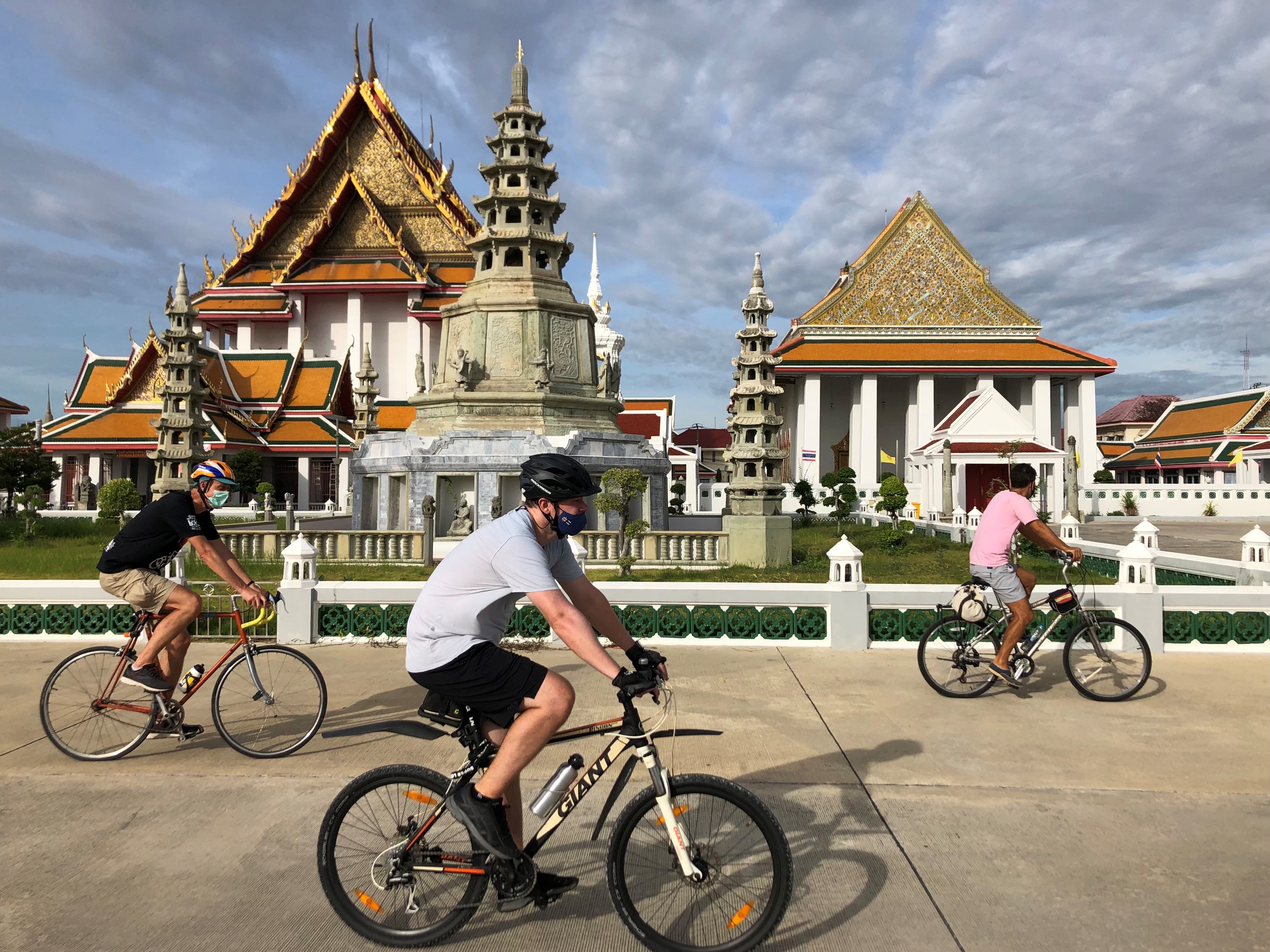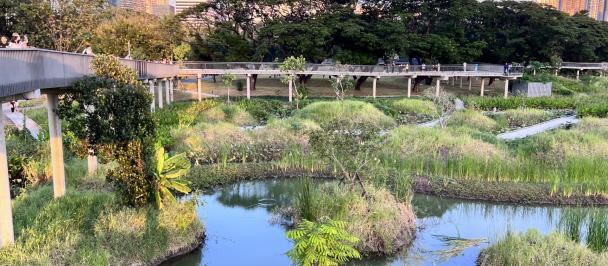“The toxic haze that blanketed the city a few months ago seems like a distant memory.” Photo: Sean Lees/UNDP Asia and the Pacific
Daybreak. I fasten my bike helmet strap under my chin, and then wrap a facemask over my ears. Despite the early hour, its hot and sticky as I greet my UNDP colleagues for a ride around Bangkok. I am not an athlete by nature, but I am eager to free myself from the confines of my apartment as we move through Thailand’s third wave of COVID infections. Travel around the country is prohibited, but movement around the city is not.
The skies are clear and purple-tinted as the morning sun washes out the remains of the evening. We make our way up a side street, and our quiet chatter mixes easily with the chirping of spot-breasted parrotbills and the whooping of koels. The toxic haze that blanketed the city a few months ago seems like a distant memory.
During those winter months, the source of Bangkok’s air pollution was the subject of many debates and woeful guessing games. What was the cause for all the smoke in the air? Was it the cold compressed air hanging over the city’s traffic-choked highways? Or was it a shift in the wind blowing in smoke from the factories to the east? Amidst all this speculation a colleague lamented, “Isn’t it ironic that during the best weather of the year, we can’t be outside?”
In January of 2021, Bangkok was identified as the city with the world’s third worst air quality. Then in March, Chiang Mai was crowned the most polluted city on the planet. According to the Bangkok Post, between January to March 5, nearly 32,000 patients were admitted to Chiang Mai hospitals for air pollution-related illnesses.
As a Specialist working for UNDP’s Business and Human Rights in Asia programme (B+HR Asia), I am well aware of the pressures industry is putting on the planet and people. Air pollution is an infringement on our right to health and right to life and puts vulnerable groups at risk, including the elderly, children, pregnant women, the poor, and people with pre-existing medical conditions.
In February, B+HR Asia hosted an online survey asking people in Asia what they believed was the region’s most significant environmental problem. Air pollution was the clear front runner, also selected by 60% of the respondents from Thailand. Further, the majority of respondents identified agribusiness and energy companies as the most significant contributors. But our survey was lacking in detail, so to learn more about the causes of air pollution, I turned to Bruno Hugel, Global Technical Advisor on Climate and Forest for UNDP.
Bruno explained that much of the air pollution we experience in Thailand in the winter is from agriculture burning, and in particular of sugar cane fields during the harvest season. Since 2010, sugar cane cultivation has grown by an average of 8% per year in Thailand. Unsurprisingly, PM2.5 emissions during harvest season more than doubled between 2007 and 2020.
In response, the Royal Thai Government has deployed incentive schemes to promote sugar cane cultivation without burning. But burning sugar cane remains a much more cost-effective approach than harvesting fresh sugarcane.
Bruno recommended that I also get the perspective of a leading expert on Thailand’s air pollution, Weenarin Lulitanonda. Weena, a Co-Founder of the Thailand Clean Air Network, tells me that sugar cane is not the only culprit. “If you talk about biomass burning, maize and rice contribute even more to air pollution,” she says. “Forest fires ignited by humans are also a huge factor. Then you have industrial pollution, vehicle pollution and transboundary haze as well.” Weena adds, “And don’t forget that there are also large variations in pollution sources between regions in Thailand.”
While the causes of Thailand’s air pollution present a unique and complex case study, the challenge of mitigating the harmful impact of business operations is all too familiar. There is no agreed equation on how to balance the income needs of farmers who may be poor, with the need to curtail climate change or air pollution under the Sustainable Development Goals.[1] How do we meet the integrated challenge of poverty reduction with environmental sustainability?
The UN Guiding Principles (UNGPs) on Business and Human Rights may provide an answer, if only a partial one. As provided for under its three-pillar approach, States have a duty to protect human rights related to adverse impacts of business. In turn, business must show respect for human rights by adopting human rights policies, conducting due diligence and providing a remedy for harms committed.
What business practices or policies might change if we view air pollution as a human rights concern? What policy changes may be in order now that Thailand has become the first country in Asia to embrace the UNGPs with a National Action Plan on Business and Human Rights? How can support be provided to smallholder farmers to ensure a just transition?
Hot but invigorated I return home from our bike ride, sit on my apartment balcony, and witness the drama of big blue skies giving way, at the fringes, to clouds heavy with rain. Thunder rumbles quietly from a distant source and I am seized with worry. How many more of these bike rides will I enjoy before the burning begins again this winter? When will we start closing off our balconies to our children again out of concern for their health?
With the help of national and international experts it is increasingly clear “what” needs to happen to tackle Thailand’s air pollution problem. It now seems more a question of “when.” As in, when will we be ready to address the challenge?
-------------
[1] SDG 3.9 seeks to “substantially reduce the number of deaths and illnesses from hazardous chemicals and air, water and soil pollution and contamination” by 2030.

 Locations
Locations

